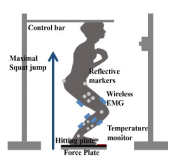
The human foot is only part that directly contact between the body and the external environment, and is ideally positioned to provide sensory information to the Central Nervous System (CNS) during static and dynamic tasks. Through cutaneous mechanoreceptors located in the dermis, the foot is able to recognize touch pressure and vibration stimuli, which provide important feedback information used for the fine coordination of movements. The purpose of this study is to quantitatively examine the effect of changing the foot cutaneous sensory by temperature stimulus on maximal performance and muscle activation using wavelet technique. Sixteen healthy subjects volunteered to participate in this study (Male: Age 21.4±2.4years; Height 174.7±5.3츠; Weight 70.6±5.2kg; Female: Age 20.5±0.6years; Height 163.2±3.1cm; Weight 55.6±4.8kg). Sensory pressure thresholds were determined for the plantar surface of the foot using monofilament. Kinematic, kinetic and EMG data which relative to maximal performance were collected while squat jumping in each temperature condition(cool 12-15℃ normal 28-30℃ hot 45-48℃). Maximal jump height was significant higher in normal condition. Vertical GRF in normal condition showed higher peak value the other conditions. And then EMG signal were significant different between temperature conditions during maximal performance. By changed sensory feedback on temperature, one can alter maximal performance and muscle activation pattern. Cutaneous feedback is important in performance and neuromuscular control, and temperature changes significantly influence on lower extremity during maximal squat jump performance of healthy subjects.






PURPOSE Increased body mass index (BMI) increases ankle instability and adversely affects human movement. This study aims to compare and analyze the muscle function and proprioception of the ankle joint based on Body Mass Index (BMI) to determine potential differences. METHODS Twenty-eight healthy male and female college students were categorized into overweight (≥ BMI 23) and normal (< BMI 23) groups. Measurements included BMI, isokinetic strength of dorsiflexion, plantarflexion, eversion, inversion, ankle joint range of motion, and ankle joint proprioception. RESULTS In dorsiflexion, right 30°/sec (p=.035), left 30°/sec (p=.009) and right 120°/sec (p=.011); in plantarflexion, left 30°/sec (p<.001), right 120°/sec (p=.007) and left 120°/sec (p=.006) in ankle inversion, left 30°/sec (p=.001), right 120°/sec (p=.021) and left 120°/sec (p=.007), left 30°/sec (p=.014), 120°/sec (p=.001) in ankle inversion-eversion ratio, right (p=.003) and left (p=.003) in ankle joint range of motion, right (p<.001) and left (p=.022) in total proprioception, and left (p<.001) in left-right proprioception were significantly different between the normal and overweight groups. CONCLUSIONS It was found that the overweight group had lower muscle strength, joint range of motion, and proprioceptive control function of the ankle joint than the normal group according to BMI. Therefore, exercise programs should be provided to strengthen the periarticular muscles involved in ankle movement, such as the tibialis anterior, soleus, and peroneus longus, and to control dynamic proprioception to prevent ankle injuries and function of the ankle joint according to BMI.